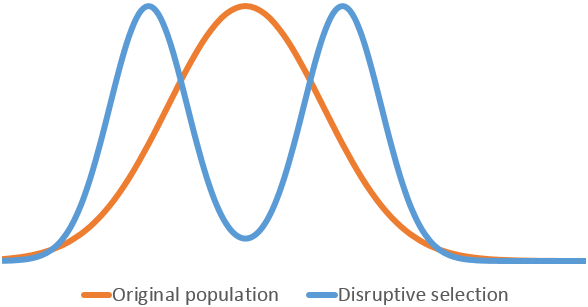Genetic divergence on:
[Wikipedia]
[Google]
[Amazon]
Genetic divergence is the process in which two or more populations of an ancestral species accumulate independent genetic changes ( mutations) through time, often leading to reproductive isolation and continued mutation even after the populations have become reproductively isolated for some period of time, as there is not any genetic exchange anymore. In some cases, subpopulations cover living in ecologically distinct peripheral environments can exhibit genetic divergence from the remainder of a population, especially where the range of a population is very large (see parapatric speciation). The genetic differences among divergent populations can involve silent mutations (that have no effect on the
 Genetic divergence can occur without geographic separation, through
Genetic divergence can occur without geographic separation, through
phenotype
In genetics, the phenotype () is the set of observable characteristics or traits of an organism. The term covers the organism's morphology (physical form and structure), its developmental processes, its biochemical and physiological propert ...
) or give rise to significant morphological and/or physiological changes. Genetic divergence will always accompany reproductive isolation, either due to novel adaptations via selection and/or due to genetic drift, and is the principal mechanism underlying speciation.
On a molecular genetics level, genetic divergence is due to changes in a small number of gene
In biology, the word gene has two meanings. The Mendelian gene is a basic unit of heredity. The molecular gene is a sequence of nucleotides in DNA that is transcribed to produce a functional RNA. There are two types of molecular genes: protei ...
s in a species, resulting in speciation. However, researchers argue that it is unlikely that divergence is a result of a significant, single, dominant mutation in a genetic locus because if that were so, the individual with that mutation would have zero fitness. Consequently, they could not reproduce and pass the mutation on to further generations. Hence, it is more likely that divergence, and subsequently reproductive isolation, are the outcomes of multiple small mutations over evolutionary time accumulating in a population isolated from gene flow
In population genetics, gene flow (also known as migration and allele flow) is the transfer of genetic variation, genetic material from one population to another. If the rate of gene flow is high enough, then two populations will have equivalent ...
.
Causes
Founder effect
One possible cause of genetic divergence is thefounder effect
In population genetics, the founder effect is the loss of genetic variation that occurs when a new population is established by a very small number of individuals from a larger population. It was first fully outlined by Ernst Mayr in 1942, us ...
, which is when a few individuals become isolated from their original population. Those individuals might overrepresent a certain genetic pattern, which means that certain biological characteristics are overrepresented. These individuals can form a new population with different gene pools from the original population. For example, 10% of the original population has blue eyes and 90% has brown eyes. By chance, 10 individuals are separated from the original population. If this small group has 80% blue eyes and 20% brown eyes, then their offspring would be more likely to have the allele for the blue eyes. As a result, the percentage of the population with blue eyes would be higher than the population with brown eyes, which is different from the original population.
Bottleneck effect
Another possible cause of genetic divergence is the bottleneck effect. The bottleneck effect is when an event, such as a natural disaster, causes a large portion of the population to die. By chance, certain genetic patterns will be overrepresented in the remaining population, which is similar to what happens with thefounder effect
In population genetics, the founder effect is the loss of genetic variation that occurs when a new population is established by a very small number of individuals from a larger population. It was first fully outlined by Ernst Mayr in 1942, us ...
.
Disruptive selection
 Genetic divergence can occur without geographic separation, through
Genetic divergence can occur without geographic separation, through Disruptive selection
In evolutionary biology, disruptive selection, also called diversifying selection, describes changes in population genetics in which extreme values for a trait are favored over intermediate values. In this case, the variance of the trait in ...
. This occurs when individuals in a population with both high and low phenotypic extremes are fitter than the intermediate phenotype. These individuals occupy two different niches, within each niche there is Gaussian trait distribution. If the genetic variation between niches is high then there will be strong reproductive isolation. If genetic variation is below a certain threshold than introgression will occur but if variation is above a certain threshold the population can split resulting in speciation.
Disruptive selection is seen in the bimodal population of Darwin's finches, '' Geospiza fortis''. The two modes specialize in eating different types of seeds small and soft versus large and hard, this results in beaks of different sizes with different force capacities. Individuals with intermediate beak sizes are selected against. The song structure and response to song also differs between the two modes. There is minimal gene flow
In population genetics, gene flow (also known as migration and allele flow) is the transfer of genetic variation, genetic material from one population to another. If the rate of gene flow is high enough, then two populations will have equivalent ...
between the two modes of ''G. fortis.''
References